Three E Minor Pentatonic Riffs
This free online piano lesson is the second in Musicarta.com’s ‘Pentatonic Scales’ series. Pentatonic Scales (1) - Lesson One in this series - introduces the six white-key-only pentatonic scales, counts off the five tones of the major and minor pentatonic scales, and offers six pentatonic ‘doodles’ for ear training.
This lesson offers three bluesy E minor pentatonic riffs which combine the simple minor pentatonic scale demonstrated in Lesson One with driving rhythms to make play-some-more blues piano performances in guitar-friendly E minor.
Rhythm is often what makes quite simple music interesting. The Three E Minor Pentatonic Riffs have rhythmic build-up material to help you master the catchy rhythms that drive the pieces along, and help you understand how they are written down in music notation. You are helped to rehearse syncopated off-the-beat playing with counting and together-left-right (TLR) analysis.
If you read music fairly well, you can start your pentatonic studies right here, but players of all abilities will benefit from completing Pentatonic Scales Lesson One and learning the pentatonic scale-tone shorthand. Players who can’t read music so well can use it to help find the notes, and players who do read well should use it to ‘get away from the dots’ and generally free up their creativity.
Getting the triplet quaver feel
All three of E minor pentatonic riffs in this module are played with the triplet or ‘swing quaver’ feel. But to keep the music looking relatively simple - and this is often done - they are written in ‘straight’ or even quavers, with the triplet or swing quaver or ‘dotted' feel indicated in the music by this little expression:

Repeating “Humpty Dumpty, Humpty Dumpty…” demonstrates the triplet or swing quaver rhythm perfectly. Then you count “1 & 2 & 3 & 4 &” to the rhythm of “Humpty Dumpty, Humpty Dumpty”:

…and this gives you the count you need to play music showing this triplet feel sign properly. The table represents the rhythm spacing accurately. The “and” count (&) is closer to the count that follows than to its own number.
Three E Minor Pentatonic Riffs: Riff One
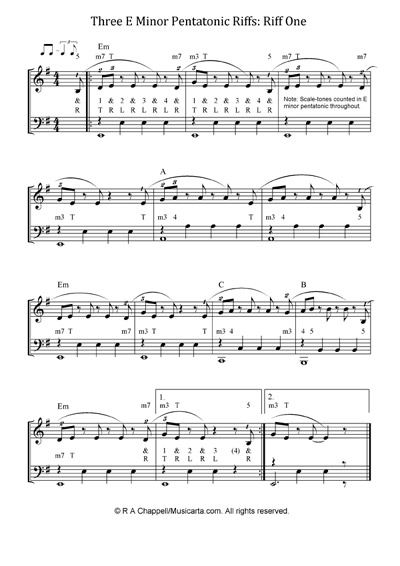
This is a thumbnail of Three E Minor Pentatonic Riffs – Riff One. Save your eyes and use the full-size version in your Pentatonic Workbook for study.
This is what it sounds like, but use the rhythmic build-up which follows to establish and practice your finger rhythm before trying to play the piece right through.
Rhythmic build-up for Riff One
Note the instruction for a swing quaver ‘Humpty Dumpty’/triplet feel. Re-read the explanation above if you’re not sure about this.
The audio clip plays each bar twice except the last bar, which repeats over and over for you to play along to.
Bar 1
- This whole riff is built on the swing quavers in Bar 1, where they are written as simply as possible. The notes are all E’s. The left hand plays E’s with the little finger (LH5) and thumb (LH1). The left hand notes are in the bass clef. The right hand plays the next E up with the third finger (RH3). Right hand notes are in the treble clef.
The order the hands play is L, R, L, R, L, R, L, R, as shown in this Together-left-right ‘table of events’:

Bar 2
- The rhythm is just the same but the left hand holds its notes for a little longer. The little finger 5 holds down for the whole bar and the thumb 1 for as long as it can while still repeating its note.
Bar 3
- The rhythm and notes are exactly the same as in bar 2 but the beaming is broken so the note stems are different. Use the Together-left-right analysis and the counting (on Humpty Dumpty rhythm) to help you. It sounds exactly the same as the previous bar – it only looks different.
Bar 4
- This is the first bar of the actual music. There is only one new note in Bar 4 – a D on the first beat, giving a T for together – and the last RH quaver has gone down to B. The table of events now looks like this:

- This bar is the pattern for the whole piece, so play it as slowly as you need to, to be sure you are playing the right things together in the right order. The speed can wait until the right things are happening in the right order.
Riff One - Lead sheet version
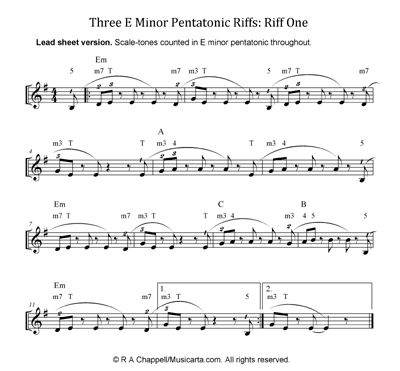
This is a thumbnail of the lead sheet version of this riff, which you can download and print.
All good pop musicians can play from lead sheets, and in this piece, it’s easy enough to put the left hand ‘on automatic’ – the left hand only plays the note in the chord symbol above the music, in the pattern you have learned.
On the lead sheet, the scale-tones are counted in E minor shorthand throughout – it doesn’t change according to the chords in the chord symbols. In simple pentatonic music, the melody is often ‘in one key’ while the chords underneath the melody can be quite varied.
Play the right hand from the lead sheet, finding the notes of the melody according to the pentatonic shorthand (T, m3, 4, 5, m7), even if you read well. This is what will free your creativity – not reading the notes.
Three E Minor Pentatonic Riffs: Riff Two
Here is a thumbnail of the second riff in this set. Use the full-size version in your Pentatonics Workbook.
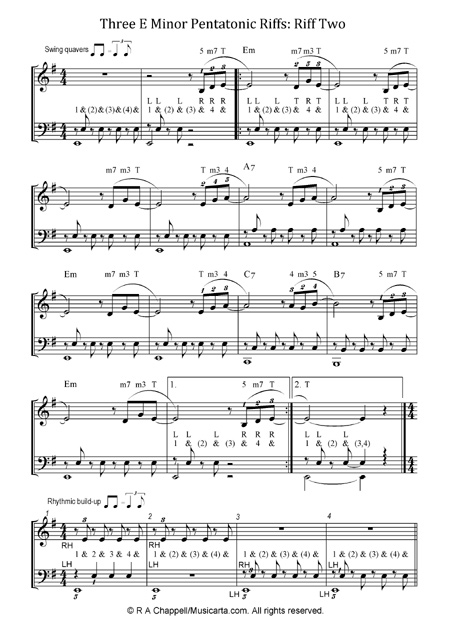
Listen to the audio track. If you can, play it straight off either from the music or by ear, but most learners will have to work through the Rhythmic Build-up to play it
Riff Two rhythmic build -up
Riff Two uses the same notes as Riff One in a slightly different rhythm. Follow this rhythmic build-up to see how.

Bar 1:
- Get the basic Riff One two-handed rhythm going, just as in the Riff One rhythmic build-up.
Bar 2:
- Stop playing the LH thumb notes. The RH notes are ‘out on their own’ on the ‘ands’ now.
Bar 3:
- Move the RH off-beat (“and”) notes down an octave into the bass clef, still playing them with the right hand.
Bar 4:
- Take the RH off-beat notes over with the LH thumb, freeing the RH to play the tune.
You might have to run through this four-part build-up quite a few times before you can slip into it straight off and keep it going when the right hand comes in. The right hand plays the same groups of notes as in Riff One, but plays them all before the bar line on counts “and four and” (& 4 &).
Pay close attention to the counts and the TLR analysis, which shows which notes (hands) come together and when. Be prepared to simplify and repeat.
Here are some sample patches from the first line of this riff and how you might practice them.

Sample 1
Count. Getting the three right hand notes on the right beat is a matter of counting. Tap your foot four to the bar and count “1, 2, 3, 4.”
Simplify. Drop the left hand thumb notes, so that there are only four significant notes – three right hand notes on counts & 4 &, and the left hand note on count 1 – all coming on their own.
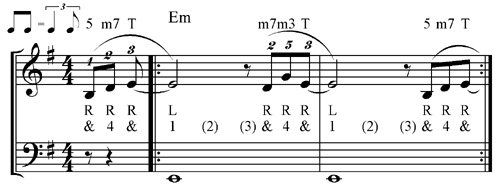
You could play the whole riff just like this, as a half-way goal.
Sample 2
Sample 2 is a great example of where it would be a good idea to drop the rhythm altogether and just get the T-L-R ‘events’ right to start with.
Again, leave the non-essential left hand thumbs out of the picture and get this mechanical even-quaver riff going:
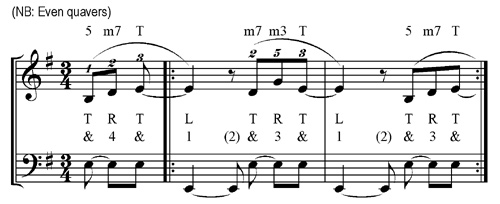
You don’t have to follow the rhythm at all, just the together-right-together-left order of events.
When you’re sure you’re getting things in the right order and it feels quite natural, go back to four-four time, swing quavers at a slow relaxed speed, and do the same ‘events’:
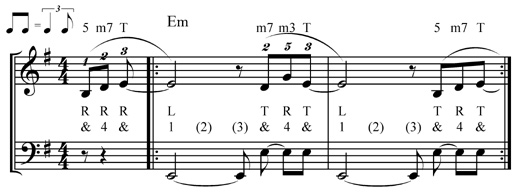
Then all that’s left for you to do is put the other two off-the-beat LH thumb quavers back in, and Riff Two is done.
Three E Minor Pentatonic Riffs: Riff Three
Here is a thumbnail of the last riff in this set.
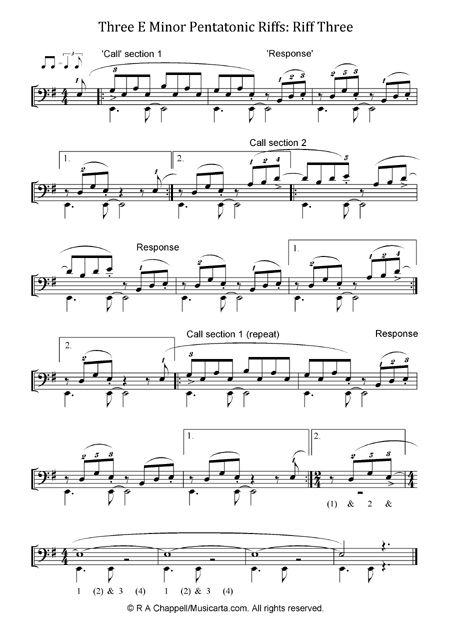
Riff Three in this set uses the ‘call and response’ pattern from the old convict chain gangs of America’s Deep South.
This riff has a long rhythmic build-up. As before, you will learn more by working through the rhythmic build-up and getting each mini-groove secure and dependable than by struggling through the music – or even just playing it straight off, if you’re that good at reading.
You don’t have to do this long build-up in one session. If you don’t want to read all the explanations, just follow the minor pentatonic short-hand and copy the audio files.
Take time out to just enjoy any groove you get going.. If you want to cut loose, remember that the minor pentatonic scale-tones are T, m3, 4, 5, and m7 and try any of these tones in your right hand.
Riff Three rhythmic build-up
RB 1

This is the basic riff but with a simplified left hand playing only on beat 1, and continuous.
- Note the indication to play to the swing quaver ‘Humpty Dumpty’ rhythm. This applies right through the build-up.
- Note that two possible fingerings are given. Experiment with both and choose what feels most natural.
- Note that the phrase starts on an off-beat ‘and’ note – “and one and two and three and four…” The last note of the bar belongs with the notes of the next bar.
RB 2
This is the same right hand as in RB1 but with the left hand playing the syncopated bass that you hear in the performance file, on beats 1 & 2 & (3 & 4 &).
The fingering will help you place the difficult off-beat (‘and’) bass note. In the example above, the left hand notes come with the right hand fingers 3 and 1. The off-beat bass note comes with the RH thumb, because the RH thumb always plays the ‘and’ notes.
The example also shows the together-left-right (TLR) analysis. Look particularly at where your hands play together (T). If you’re not getting the riff, slow it right down and make sure that T R R T does really happen on 1 & 2 &, then build the speed back up.
To help get the rhythm, try running examples 1 and 2 together, as in the audio clip that follows. Get some momentum going with the simple bass, then try putting the difficult off-beat note in.
RB 3

RB 3 is the same as RB 2, but stops off in the second bar. The important thing is to get the last note in the second bar on the correct beat to start the repeat. It is on 4’s ‘and’. You will find counting out loud helpful.
Notice that the three build-up segments so far (RB 1, 2 and 3) above can be run together. The next segment does not follow on though, so when you have done enough repetitions, stop where it says ‘Fine’. ‘Fine’, pronounced ‘fee-nay’, is Italian for ‘finish’. A lot of the written terms used in music are Italian.
RB 4
This section is the first part of the ‘response’. You revert to the simple bass for the time being.

You ‘count yourself in’ for this segment. To get the right hand notes in the correct rhythm, you have to hear the basic beat – the four cross-head notes – before you start playing. Don’t play them - tap your foot and say them (still on the Humpty Dumpty rhythm) and then start playing on three’s ‘and’.
RB 5
RB 5 is the same as RB 4 but with the syncopated bass put back in.

This practice segment follows on from the previous one, so you could build up the rhythm with RB 4 first and then put the syncopated bass note in. Finish at Fine, because the next practice segment does not follow on.
RB 6
Segment 6 is the second part of the ‘response’.

RB 7

RB 7 is the whole of the ‘response’, but with an extra bar tucked in to let you ‘catch your breath’. It’s quite a nice stand-alone riff. Count yourself in again.
RB 8
Here is the whole of the response, now without the extra bar but with the simplified bass.

Play the last four notes ‘& 4 &’ to lead in to the next segment.
RB 9
The whole of the response, continuous, with proper syncopated bass part. Does not carry on – end at ‘Fine’.

You have now rehearsed all the elements of bars 1 to 4, which are repeated at the end of the piece – so you’re more than half-way there. The rest of the practice segments rehearse the second ‘call’ section. This has the same rhythm as the response (which you have already learned), so it will be easier to grasp.
RB 10

The crossed note-heads in the first bar represent you counting yourself in. The bass is simplified. This segment has the same rhythm as RB 4, and leads straight into the next segment.
RB 11

This is the same right hand as RB 10 but with the syncopated bass. Does not carry on – stop at Fine.
RB 12

This is the second part of the new ‘call’ section.
RB 13

The whole of the second call section, counted in. In the actual performance, you stop repeating at Fine and go straight into the response.
You have now rehearsed every segment of Riff Three. Here is the performance audio again.
- Follow the audio in the music to make sure you see how the repeat marks work.
- Try to play along with just the right hand.
- See how much you can play two-handed on your own, at your own speed.
The piece ends with a little twist created by slipping an extra half bar in. Check the counting given in the music carefully. Remember that these three pentatonic riffs are not exam pieces.
This is the end of Musicarta’s Pentatonic Scales Lesson Two. In the next module, you learn how to build pentatonic major and minor scales on any root, and access the Visual Glossary of Pentatonic Scales to make practicing your pentatonic improvisation easier. There is another batch of riffs too.
In Lesson Four, we add the two extra chromatic (semitone) pentatonic scale tones which are regularly squeezed into the pentatonic scales and will make your jamming sound even better.
In the meantime, be sure to check out the tabs on the navbar of the Musicarta home page. These are directory pages with explanations and links through to all Musicarta’s free piano lessons online.
Thanks for visiting Muicarta.com! Come back soon!
|
|
|
|
|
OUT NOW! |
THE MUSICARTA BEAT & RHYTHM WORKBOOK At last! An effective approach to keyboard rhythm & syncopation skills. Learn more! |
ONLY $24.95! |
|
THE MUSICARTA PENTATONICS WORKBOOK video course Home/Index pages The Pentatonic Scales
Practice Patterns
Melody Work and
Playing by Ear
Pentatonic Riffs
and Diaries - Minor Pentatonic Major Pentatonic
Chromatic Minor
Chromatic Major
Pre-video Pages
Pentatonics videos
Archive Pages
|
The MusicartaA methodical approach to keyboard syncopation for
|
PUBLICATIONS
exciting keyboard
creativity courses
CHORDS 101
WORKBOOK

~HANON~
video course

Musicarta
Patreon
PENTATONICS
WORKBOOK
video course

Creative Keyboard
video course

BEAT AND RHYTHM
WORKBOOK

- Volume 1 -

12-BAR PIANO
STYLES WORKBOOK

MUSICARTA MODES
WORKBOOK

PIANO STYLE

CANON PROJECT
video course

VARIATIONS
video course


- Piano Solo -
video course

- Piano Solo -


YouTube playlists


